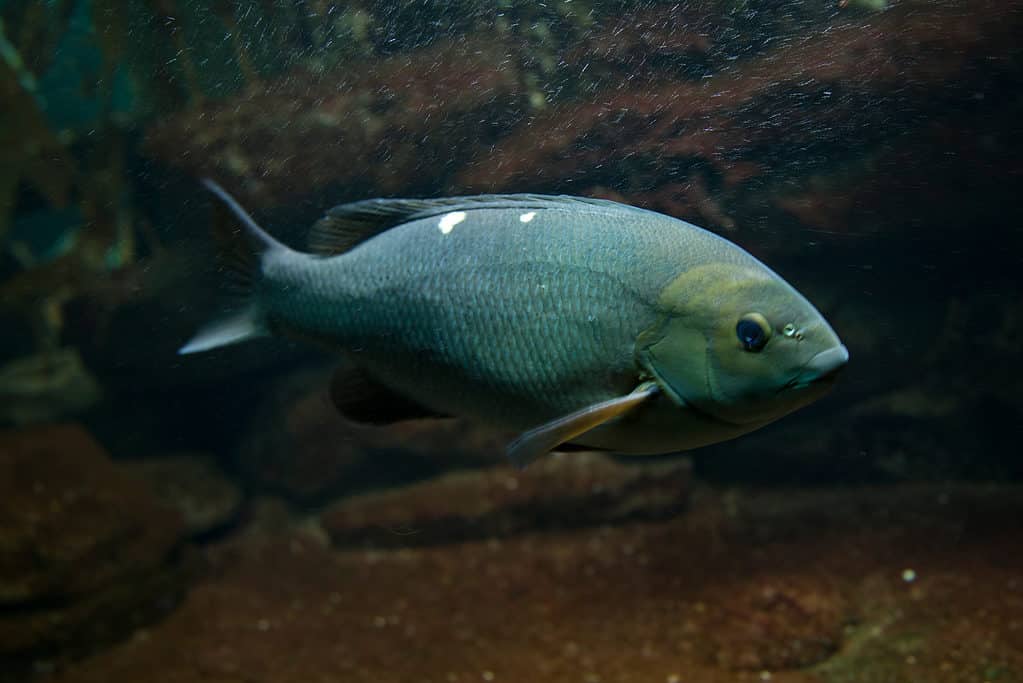Opaleye (Rudderfish)
Girella nigricans
Some indigenous people of the Pacific coast of North America consider opaleye fish sacred food and use it in traditional ceremonies.
Advertisement
Opaleye (Rudderfish) Facts
- Fun Fact
- Some indigenous people of the Pacific coast of North America consider opaleye fish sacred food and use it in traditional ceremonies.
- Other Name(s)
- Rudderfish
- Diet
- Omnivore
Opaleye (Rudderfish) Physical Characteristics
- Color
- Yellow
- Blue
- Black
- Green
- Skin Type
- Scales
- Age of Sexual Maturity
- 2-3 years
View all of the Opaleye (Rudderfish) images!
Opaleye is a species of fish indigenous to the Pacific coast of North America. It is a member of the Pleuronectidae family, which includes other flatfish such as soles and flounders. They live in rocky tide pools and intertidal areas where they can reach lengths of up to 25 inches and weigh 13 pounds fully grown. Their primary food sources are small invertebrates, algae, and crustaceans. This fish is well-known as a sporting fish and a well-liked angling species. It is a valuable commercial fish caught with hook, line, and gillnet.
Fun Facts About the Opaleye Fish
- Some indigenous people of the Pacific coast of North America consider opaleye fish sacred food and use it in traditional ceremonies.
- The opaleye fish is known for their ability to change color to match their surroundings — a behavior known as camouflage.
- They are found in rocky intertidal pools and tide pools along the pacific coast of North America.
- They are known for their distinctive silver-green color and black spot near the tail.
Opaleye Classification and Scientific name
This fish species is placed in the order Perciformes and belongs to the family Girellidae. The scientific name of the opaleye is Girella nigricans.
Opaleye Appearance

Opaleye display a unique bright blue eye outlined with a black circle.
©Podolnaya Elena/Shutterstock.com
The opaleye fish is a marine fish known for its bright coloration and challenging-fighting nature. Their scales reflect a greenish-blue to black tone, added with a silver-white belly. These fish display a unique bright blue eye outlined with a black circle followed by a beautiful opal color that shimmers and changes in the light, giving it its name — the opaleye.
The fins are also typically a greenish-blue to black hue that has a yellow margin that lies on the tail fin. Their long, slender, oval-shaped body allows them to glide and swim easily in the water. Their striking appearance makes them a suitable choice for aquariums.
Opaleye Distribution, Population, and Habitat
From Point Conception in southern California to Punta Abreojos in Baja California, Mexico, this marine fish can be found along the coasts of these two countries. These relatively small fish occur in rocky areas, and nearshore kelp beds found from the intertidal zone to depths of up to 105 feet. The population of the opaleye fish reveal that they are not threatened or endangered. However, the exact population size of these fish are not known.
The opaleye fish is well adapted to its rough habitat, known for its hardiness and adaptability as they feed on small crustaceans, mollusks, and seaweed. These fish are classified as minor commercial species and are favored to catch during sport fishing. These easily adapted fish are not only home to shallow reefs but also can inhabit living in an aquarium.
Opaleye Reproduction and Lifespan
The opaleye fish reproduces through spawning, meaning they release their eggs and sperm into the shallow water column, where fertilization takes place. Spawning takes place during April and June. Their free-floating eggs and larvae drift down these shallow reefs and are found several miles from the coast.
Once these eggs hatch, the young fry form schools of up to twenty individuals, where they will enter tidepools and mature. When these fish reach an age of two to three years old, they are ready to reproduce and spawn.
The lifespan of an opaleye fish can live up to ten years. However, they prefer warmer water, where temperatures should be around 75-80 degrees Fahrenheit, and require plenty of oxygen. Nevertheless, with the right conditions and care, these fish can live a long and happy life.
Opaleye in Fishing and cooking
You’ll need a fishing rod, reel, and the right line to catch the opaleye. Worms, mussels, and small pieces of fish are among the baits that have been successfully used to catch opaleye. You can also use artificial lures that resemble small fish or crustaceans, like jigs or spinners.
Opaleye are most active in the early morning and late evening, so these are the best times to go fishing for them. Your fishing spot should be situated around coastal areas near a pier, as they tend to congregate there. Once you have found a likely site, cast your line and wait patiently for a bite.
Remember, opaleye is a protected species in California, so check the regulations regarding their harvest before you go fishing.
The meat of the opaleye has a mild and sweet flavor and is white and flaky. There are many ways to prepare opaleye fish, including grilling, baking, broiling, or frying. Additionally, it may be included in chowders, stews, or soups, also regarded as a good option for sashimi and sushi. However, it is vital to be informed that some fish species, such as opaleye, may contain high concentrations of mercury, which, if consumed in large amounts, can harm human health. Therefore, it is wise always to check the local authorities’ recommendations for safe consumption and modify your consumption as needed.
Related Animals
View all 66 animals that start with OOpaleye (Rudderfish) FAQs (Frequently Asked Questions)
What is so unique about the opaleye fish?
These fish species display a unique bright blue eye outlined with a black circle followed by a beautiful opal color that shimmers and changes in the light, giving them its name — the opaleye.
How does the opaleye fish reproduce?
The opaleye fish reproduces through spawning, meaning that they release their eggs and sperm into the shallow water column, where fertilization takes place. Spawning takes place during the months of April and June.
What do opaleye fish eat?
Crustaceans, mollusks, and seaweed.
Where can opaleye fish be found?
From Point Conception in southern California to Punta Abreojos in Baja California, Mexico, this marine fish can be found along the coasts of these two countries.
Thank you for reading! Have some feedback for us? Contact the AZ Animals editorial team.
Sources
- pier fishing, Available here: https://www.pierfishing.com/opaleye/
- marine species, Available here: https://marinespecies.wildlife.ca.gov/opaleye/false/
- catch and fillet, Available here: https://catchandfillet.com/how-to-catch-opaleye/

















